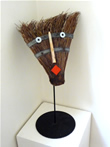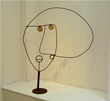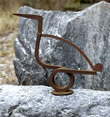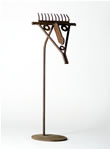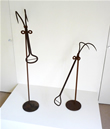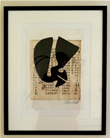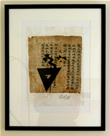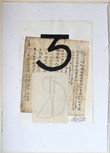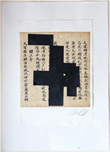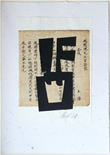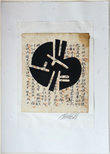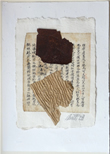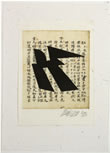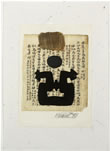Howard Smith's work emanates exuberance. The vibrancy it conveys comes in part from a personal conviction that good cheer is, despite the odds, the only reasonable option. It also springs from the blood: he is New Jersey-born of an African heritage that has resolutely transmuted violent deracination into a joyful noise. And it stems as well from the abiding pleasure he takes in the ably hand-wrought object.
The artisanal was a principal reason he was drawn to his adopted country, Finland, where he has lived for most of going on half a century. His first stay was in the very early 60s, when the signature Finnish design aesthetic of less as more was winning wide acclaim. He found that this immaculate minimalism had its wellspring in a venerable Finnish tradition of competent craft, a remarkably widespread capacity to improvise, with an economy of effort, from whatever materials were at hand. It was a mode of operation already inherent in his own work; and much of his subsequent career has served to gently contest the disjunction, prevalent in art establishment circles, between art and craft, between head and hand.
He works largely in artisan materials, those from which humans and other animals shape their dwelt environment - wood, pigment, clay, fibre, paper - and over the years has used them all in creating textiles, tableware, and decor objects for such preeminent Finnish firms as Iittala, Artek, Arabia, Wärtsilä and Hackman. He finds paper particularly congenial and returns to it tirelessly, sculpting, cutting, texturing and colouring it to produce a body of work singular in its imaginative scope, technical virtuosity and sheer volume. He also delights in metamorphosing the castoff - the tatty garment, the rusted machine part, the scrap of cardboard, the used broom. A few deft changes recycle the workaday as whimsy. His assemblies of found scrap metal are often so buoyant they seem about to dance.
The intrinsic visual and tactile qualities of these objets trouvés are often burnished by human use, an attribute he cherishes and preserves by working around it. His collages and appliqués are an exercise in experimental archeology. His treatment of durable surfaces with sgraffito, scumble and impasto imparts patina. His fascination with the past is reflected too in frequent allusions - to hieroglyphs, calligraphy, illuminations and drôleries. Much of his work suggests history dexterously augmented with a fresh stratum.
The layer he adds is one of generous optimism: bold gestures in line, plane and mass, rich energetic colors, contrapuntal contrasts in material, form and context. But it is a generosity disciplined by an infallible sense of proportion and equilibrium. Each work pleases as an artifact of poised order.
Now past eighty, Howard Smith continues to live and work in Finland, in a rebuilt apple barn overlooking the 17th-century ironworks village of Fiskars, namesake of the ergonomic scissors and now a remarkable artisans' collective. The house, its furnishings and the surrounding sculpture park constitute a consummate Gesamtkunstwerk that may be considered in itself a signal achievement. The Finnish state recently awarded him a lifetime annuity in recognition of his work, an acknowledgment of Howard Smith as a national treasure.
© Tim Steffa
Curriculum Vitae
Howard Smith was born 1928 in Moorestown, New Jersey where he spent his schooling years. In 1949 he joined the army, was promoted sergeant in 1950 and posted to Japan and Korea. He was later posted to West Germany before being honourably discharged from the army in 1958. He began art studies at the Pennsylvania Academy of Fine Arts in Philadelphia in 1960, of which he became a fellow in 1962. He made his first trip to Finland in the same year as a member of the Young America Presents group and remained there, working supported by an art oriented advertising agency. He had his first private exhibition in Helsinki 1963, produced many interior designs, as well as spending a short time as an assistant to Kaj Franck at the Institute of Applied Arts in Helsinki. He exhibited widely in Finland in the 1960’s and early 1970’s as well as completing a number of large commissions for murals and colour schemes. He became well known to large audience with his interior textiles for Vallila Interiors. In1976 he moved back to the United States, to California, where he stayed until 1984. On his return to Finland he became a visiting artist at the Arabia ceramics factory in Helsinki, and designed for them from 1986-1995. In 1988 he and ceramic artist Erna Aaltonen formed the Arteos Studio, a collaborative ceramic/art project. They moved to Fiskars near Helsinki in 1996, where they continue to live today. |
|
|
|
Solo Exhibitions |
|
|
|
1963 |
Drawings & paper collages, Galeria Pinx, Helsinki |
1965 |
Paper collages, watercolours, paintings, drawings & sculpture, Galeria Pinx, Helsinki |
1967 |
Appliqués, Artek shop, Helsinki |
|
Paper collages, watercolours, prints & sculpture, Tromsø Museum, Tromsø, Norway |
1968 |
Appliqués & multiples, Waino Aaltonen Museum, Turku |
1969 |
Printed fabrics & appliqués, Asko Furniture Company, Oulu |
1970 |
Serigraphs, University of California, Haywood |
1974 |
Object collages, Hermes Club, Helsinki |
1976 |
Paintings, The Gallery (later Gallery Tanner), Los Angeles |
1978 |
Prints, tapestries, printed textiles & masks, Clark Humanities Museum, Scripps College, Claremont |
1980 |
Masks, Beyond Baroque Foundation, Venice City Hall, California |
1981 |
Prints, appliqués & masks, Chi-Wara Gallery, Atlanta, Georgia |
1982 |
Prints, wooden sculptures & appliqués, Museum of African American Art, Los Angeles |
1984 |
Artek salesroom, Helsinki |
1985 |
Papercuts, paintings on paper & reliefs on handmade paper, Galleria Bronda, Helsinki |
1986 |
Ceramics, Galleria Bronda, Helsinki |
1987 |
Ceramics, Amos Anderson Art Museum, Helsinki |
1988 |
Collages of handmade paper and wastepaper, Tervakoski Meeting Hall, Janakkala |
1989 |
Ceramic clocks, Verlaramta, Tampere |
1990 |
Prints on handmade paper, Siltakatu branch, KOP Bank, Joensuu |
1991 |
Ceramics, Vuorelma, Lahti |
1992 |
30-year retrospective, Hämeenlinna Art Museum |
1993 |
30-year retrospective, Savonlinna Art Museum |
1997 |
Works in paper, Galleria Bau, Helsinki |
1999 |
Works in paper, Korttien Talo, Hämeenlinna |
2002 |
40-year retrospective, Galleria Nefret, Turku |
2003 |
About Faces, masks, Kuparipaja, Fiskars & touring - Kanneltalo, Helsinki & Vuotalo, Helsinki |
2007 |
Masks, paper collages and papercuts, Galleria Nefret, Turku |
2008 |
80th Birthday Exhibition, Kuparipaja, Fiskars |
2009 |
Metalworks, Masks, Papercuts, Galerie Besson, London |
|
|
Teaching: |
|
|
|
1970 |
Lecturer, Art Department of the University of California, Haywood, California |
1980-84 |
Lecturer, Art Department of Scripps College, Claremont, California |
1980 |
Lecturer, La Verne College, California |
1984 |
Lecturer, University of Art and Design, Helsinki |
1987 |
Lecturer, Department of Art History, Abo Akademi, University of Turku |
|
|
Awards and distinctions: |
|
|
|
1992 |
Grant from the State Design Council |
1993 |
Prize of the Ida Aalberg Society, Janakkala |
|
Grant from the municipality of Janakkala |
2001 |
State Design Prize |
2002 |
Honorary member of the Fiskars cooperative of artisans, designers and artists |
2003 |
Granted a state artist’s pension |
|
|
Works in Public Collections: |
|
|
|
Arabia Ceramics Museum, Helsinki |
|
|
|
Bibliography: |
|
|
|
Howard Smith, Jussi Suomala, 2008, Like |
|




